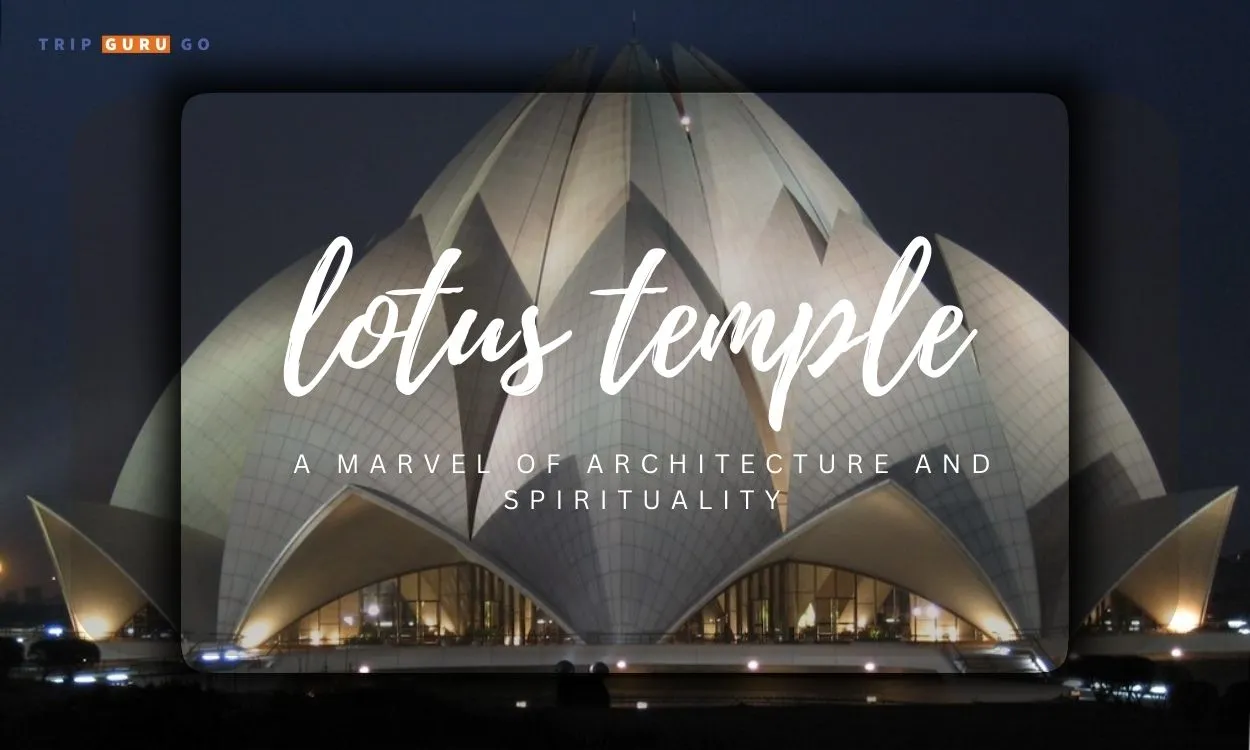Introduction:
The Lotus Temple, located in bustling Delhi, is a symbol of peace, architectural grandeur, and spiritual enlightenment. It’s known as the “Lotus of Bahá’u’lláh’s Revelation,” captivating visitors globally, transcending cultural and religious boundaries. The iconic structure is one of the planet’s most visited religious places to visit in Delhi holding immense significance.
In this blog, we explore a captivating lotus-shaped marvel’s history, architecture, and spiritual essence. It draws countless devotees and tourists. Delhi’s famous Lotus Temple offers breathtaking design, serenity, and knowledge of the Baha’i Faith. It’s an unforgettable experience.
History of Lotus Temple
A. Baha’i Faith and its Principles
The Baha’i Faith, founded by Baha’u’llah in the mid-19th century, emphasizes unity among humankind. It believes in one God, harmony in all religions, gender equality, eliminating prejudice, and achieving world peace. The concept of progressive revelation includes divine messengers like Krishna, Buddha, Moses, Jesus, Muhammad, and Baha’u’llah, guiding humanity.
B. Origins of the Lotus Temple: Founding & Purpose:
The Baha’i community in India conceived the concept of the Lotus Temple during the 1970s. The main purpose was to create a space for people of all beliefs to gather, pray, and meditate together. The Baha’i Faith’s central tenet of unity among humanity, races, cultures, and religions drove the temple’s construction.
In 1980, the Bahá’í community chose the renowned architect Fariborz Sahba from Iran to design this iconic temple. He aimed to create an architectural masterpiece reflecting Baha’i Faith’s spiritual principles. The temple’s design was inspired by the lotus flower, symbolizing purity and spiritual awakening in many cultures.
C. Lotus Temple Development Timeline:
- April 1980: Architect Fariborz Sahba’s design for the Lotus Temple is selected.
- January 1981: Construction work commences on the temple complex in New Delhi, India.
- November 1986: The project achieves a significant milestone as it completes the main structure of the Lotus Temple.
- December 1986: The architects meticulously worked on the temple’s interior and landscaping to ensure a serene and meditative ambiance.
- December 1986: The Lotus Temple is open to all, welcoming visitors of all faiths to experience beauty and tranquility.
- July 1987: The Lotus Temple is formally dedicated and consecrated with Baha’i representatives and global dignitaries present.
- 1994: The temple complex undergoes further development, including the addition of facilities to accommodate an increasing number of visitors.
The Lotus Temple attracts millions of visitors seeking solace, marveling at its architecture. It symbolizes unity, love, and brotherhood in the Baha’i Faith, inspiring people from all backgrounds to find spiritual fulfillment.

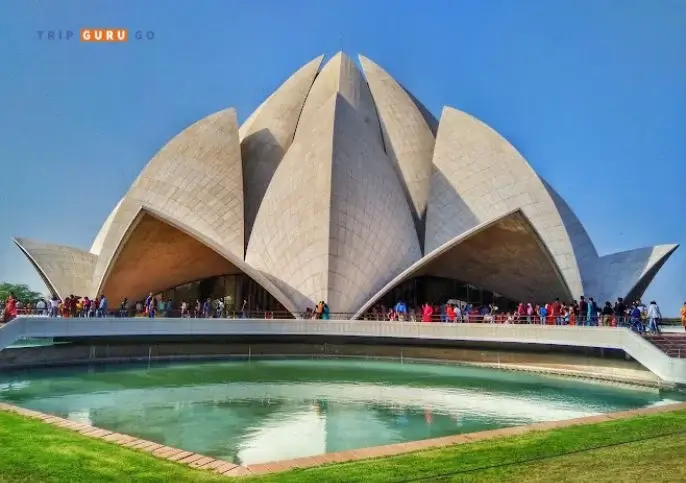
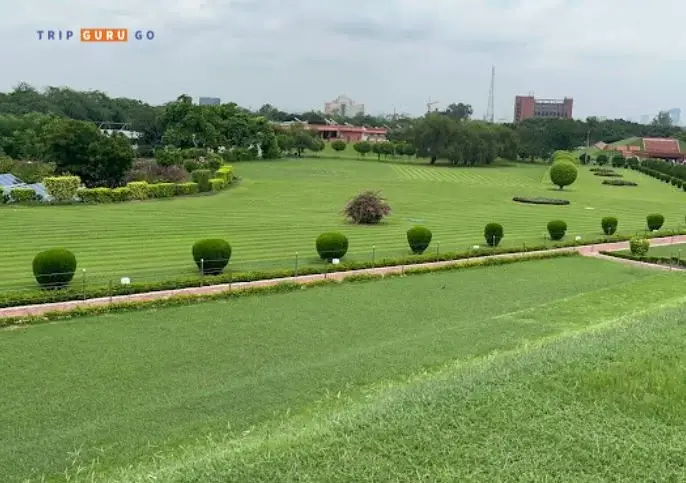

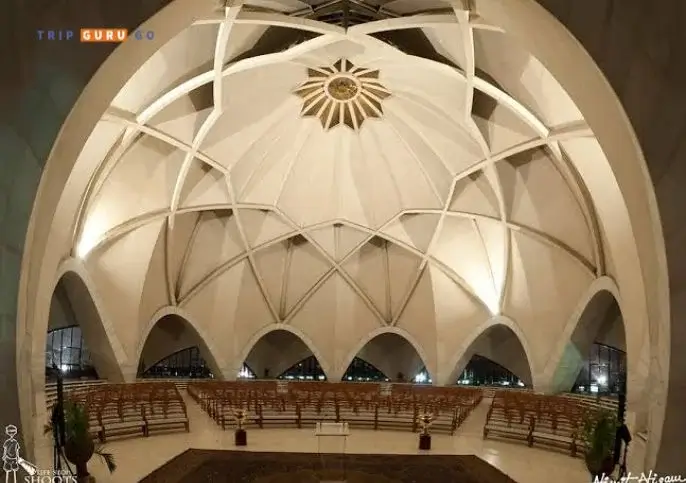
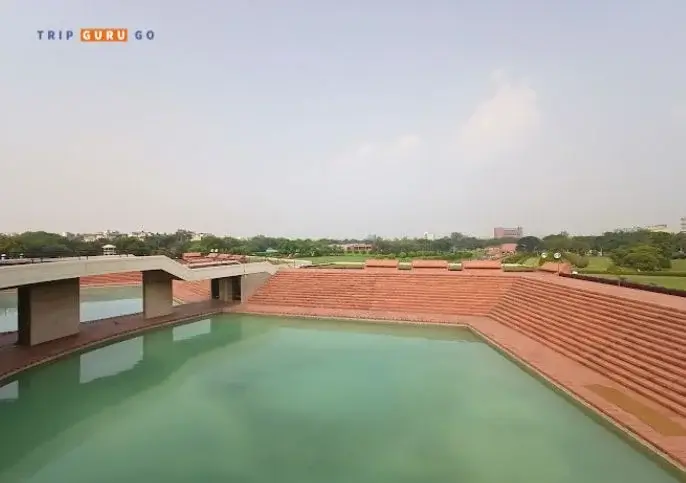
The architecture of the Lotus Temple:
A. Lotus-Shaped Structure: Unfolding Design Inspirations:
The design of the Lotus Temple draws its inspiration from the exquisite beauty and symbolism of the lotus flower. The lotus holds profound spiritual significance in various cultures and religions, symbolizing purity, enlightenment, and rebirth. The Baha’i Faith envisions humanity transforming from ignorance to spirituality like a lotus rising from murky waters to bloom in pristine light.
The lotus-shaped structure consists of 27 free-standing marble-clad petals arranged in clusters of three, forming nine sides. These petals gracefully rise to a height of 34 meters, creating an awe-inspiring focal point visible from afar. The temple’s design cleverly captures the lotus flower’s essence, inspiring serenity and spiritual awakening in visitors.
B. Architectural Team’s Vision for Worship & Meditation Place:
The architectural brilliance of the Lotus Temple is credited to renowned Iranian architect, Fariborz Sahba. Sahba and his team aimed to create an architectural marvel, a sacred space that transcends religious boundaries, embracing humanity’s oneness. The design brief emphasized a place of worship and meditation for everyone, regardless of beliefs or backgrounds.
The architectural team’s vision centered on achieving a seamless integration of art, spirituality, and environmental sustainability. The team aimed to blend lotus-inspired design with Baha’i Faith principles. Their goal was to create a space for solace, meditation, and a profound connection with the divine.
C. Construction and Building Materials for the Lotus Temple
The construction of the Lotus Temple involved meticulous material selection and innovative techniques, bringing the architect’s vision to life. The careful choice of materials ensured structural integrity and aesthetic appeal, making it an enduring symbol of beauty and spirituality.
- White Marble: The architects sourced pure white marble from Rajasthan’s renowned Makrana quarries to construct the Lotus Temple’s outer structure. The high-quality marble radiates beauty, purity, and durability, giving the temple an ethereal glow. It symbolizes purity and spiritual enlightenment.
- Steel Framework: A steel framework served as the temple’s backbone, providing strength and stability to support the delicate marble petals. Craftsmen prefabricated petals individually and assembled them on-site, creating a stunning lotus shape.
- Reinforced Concrete: Reinforced concrete plays a crucial role, providing a solid foundation and structural stability. It served as a sturdy platform for integrating the steel framework and marble cladding, achieving the desired lotus design.
- Precise Cladding and Assembly: Exceptional craftsmanship meticulously carved and assembled each of the 27 marble petals onto the steel framework. Talented artisans realized the architect’s vision, crafting a seamless, visually stunning lotus-shaped structure that inspires spiritually.
- Environment-Friendly Design: The Lotus Temple’s construction also incorporated environment-friendly elements. Natural lighting and ventilation systems cut the temple’s energy use, aligning with the Baha’i Faith’s eco-focus.
The Lotus Temple is a marvelous marvel, blending creativity and spirituality. Its lotus-inspired design, clad in white marble, symbolizes purity and enlightenment. The Baha’i Faith’s values of unity and oneness are represented. The captivating beauty leaves a lasting impression of peace and harmony on visitors.
Famous Temples of Delhi Read more…
D. Lotus Flower Symbolism & Representation in Temple Design:
The lotus flower is highly symbolic in diverse cultures and religions. The Lotus Temple incorporates this revered flower as a central motif, embodying profound meanings and representing the Baha’i Faith’s essence.
- Purity and Enlightenment: The lotus symbolizes purity and enlightenment, rising from muddy waters to bloom into a pristine blossom. At the Lotus Temple, it inspires visitors to transcend life’s challenges, seeking a higher state of consciousness.
- Universality and Oneness: The lotus symbolizes universality and oneness, embracing diverse petals within its circle. The Lotus Temple represents Baha’i unity, welcoming all to unite in harmony, celebrating diversity, and embracing shared spiritual values.
- Resilience and Immortality: The lotus symbolizes resilience and purity, untouched by impurities. The Lotus Temple’s design inspires spiritual resilience, urging people to find inner strength and embrace the eternal human spirit.
- Selfless Devotion and Service: The lotus’s self-cleaning reflects the Baha’i principle of selfless devotion, seen in the Lotus Temple. It inspires visitors to purify their hearts, serve humanity with love and compassion, and contribute to a better world.
- Transformation and Rebirth: The lotus symbolizes transformation and rebirth. It emerges from murky waters, representing spiritual transformation. The Lotus Temple embodies the journey to enlightenment.
Representing the lotus flower, the Lotus Temple goes beyond aesthetics, embodying the Baha’i Faith’s core principles. Its symbolism inspires contemplation of unity, purity, resilience, and spiritual growth, fostering higher consciousness and collective understanding.
The Spiritual Experience
A. The Inclusive & Universal Ethos of Baha’i Faith:
At the heart of the Baha’i Faith is the belief in the oneness of humanity and harmony among religions. Baha’is promote peace, justice, and equality, working for the betterment of society and civilization. The Lotus Temple welcomes people of all faiths to unite in prayer and meditation. It embodies an ethos of collective worship and reflection, promoting transformative power. It recognizes the validity of all religious traditions and honors the divine guidance of prophets and messengers throughout history.
B. Exploring Tranquility: Inside the Lotus Temple:
Upon stepping inside the Lotus Temple, visitors experience a serene ambiance that encourages introspection and inner peace. The central prayer hall’s emptiness represents the Baha’i Faith’s universality and all-encompassing nature. It lacks religious symbols or idols.
The temple’s skylight fills the hall with gentle rays of natural light, fostering a calming atmosphere. Hushed prayers and meditative thoughts create a serene environment, facilitating spiritual contemplation and connection with the divine.
Visitors have the freedom to express devotion and spirituality in their unique way. They find solace through silent prayer, meditation, or reflection in the tranquil Lotus Temple. There are no prescribed rituals or dogma. Spiritual nourishment awaits within its embrace.
Cultural Significance
A. Lotus Temple: Symbol of Interreligious Unity and Harmony:
The Lotus Temple symbolizes unity and harmony among diverse religions. Its inclusive design reflects the Baha’i Faith’s core principle of oneness and the universal source of spiritual teachings. Welcoming people from all faiths, it fosters collective worship and prayer, promoting interfaith understanding and a compassionate world. The temple stands as a reminder of humanity’s shared spiritual journey and the universal principles that bind us together.
B. Promoting Religious Tolerance & Interfaith Dialogue in India:
The Lotus Temple in India plays a vital role in promoting religious tolerance and interfaith dialogue. Situated in Delhi, it exemplifies religious harmony in the heart of the nation. By transcending religious boundaries, the temple fosters meaningful discussions, mutual respect, and social cohesion. Through inclusive gatherings and community projects, it unites people of diverse backgrounds in pursuit of shared values and collective progress. The temple’s inclusive atmosphere encourages dialogue, breaking down barriers, and fostering a culture of unity in a diverse society.
C. Temple Visitor Rituals and Practices:
At the Lotus Temple, there are no set rituals or religious ceremonies. Visitors engage in personal prayers, reflections, or meditation, drawing from their own beliefs. We encourage respectful silence to preserve the meditative atmosphere, honoring diverse spiritual practices. The temple hosts events promoting interfaith dialogue and artistic performances that inspire unity. The spiritual experience transcends religious boundaries, inviting all to seek peace within and embrace the oneness that binds humanity together. It stands as a testament to the transformative power of collective worship and universal values.
Timings and Visitor Information
A. Lotus Temple Operating Hours by Day:
The Lotus Temple welcomes visitors throughout the year, offering a place of solace and spiritual reflection. The operating hours of the temple vary slightly on different days of the week:
- Monday to Friday: The Lotus Temple is open to visitors from 9:00 AM to 5:30 PM.
- Saturday and Sunday: The temple is open from 9:00 AM to 7:00 PM. Extended evening hours offer a serene ambiance for visitors.
B. Ideal Time to Visit for Serenity and Solitude:
For a serene experience at the Lotus Temple, visit on weekdays, especially Monday, Tuesday, or Wednesday. During these weekdays, the temple typically receives fewer visitors compared to weekends, allowing for a more peaceful and meditative experience.
Another ideal time to visit is during the early morning hours when the temple opens. Arriving at 9:00 AM when gates open allows quiet exploration before larger crowds gather later.
C. Facilities for Disabled Visitors:
The Lotus Temple aims to be inclusive and accessible to all visitors, including those with disabilities. The following facilities and amenities are available to ensure a comfortable visit for disabled individuals:
- Wheelchair Accessibility: The temple complex has designed ramps and designated pathways to facilitate easy movement for wheelchair users, making it wheelchair-friendly.
- Wheelchair Rental: Complimentary wheelchair rental services are available for visitors who may require assistance. These wheelchairs can be availed at the Visitor Centre.
- Assistance for Visually Impaired Visitors: For visually impaired visitors, the temple provides guided assistance to navigate through the complex and experience the beauty of the architecture and surroundings.
- Accessible Seating: The Bahá’í House of Worship’s central prayer hall provides special seating arrangements to accommodate individuals with mobility challenges, ensuring their comfort during moments of meditation or prayer.
- Accessible Restrooms: The temple complex includes accessible restrooms equipped with facilities for disabled visitors.
- Parking Facilities: Designated parking spaces for persons with a disability, are available near the temple entrance for convenient access.
The Lotus Temple ensures a welcoming experience for all visitors. Staff are ready to help with any needs or accommodations. They aim for a pleasant visit.
Entry Fee and Donations
A. Information on Entry Fees & Activity Charges:
The Lotus Temple does not charge any entry fee for visitors. The place welcomes all, free of cost, to experience spiritual ambiance and architectural splendor regardless of beliefs.
The temple doesn’t charge for prayer, meditation, or contemplation. Visitors can participate as they prefer without financial obligations.
The Lotus Temple offers free entry, embodying the Baha’i Faith’s belief in universal spiritual accessibility. It actively ensures inclusivity and accessibility for all.
B. Supporting Temple Maintenance & Activities: Donations & Contributions
The Lotus Temple allows free entry but welcomes voluntary donations for maintenance and activities. These donations play a crucial role in supporting various aspects of the temple’s operations, including:
- Maintenance and Upkeep: Donations maintain the temple’s pristine condition, preserving its beauty and tranquility for visitors.
- Community Services: Contributions fund community service initiatives: education, healthcare, and support for the underprivileged at the temple.
- Interfaith Dialogue and Programs: The Lotus Temple fosters interfaith dialogue, seminars, and cultural events to promote harmony among diverse religions. Donations support hosting these events.
- Visitor Amenities: Donors can enhance visitor amenities: by improving accessibility for persons with disabilities individuals, upgrading facilities, and ensuring visitor comfort.
- Social and Environmental Initiatives: The temple can allocate funds for eco projects and support social welfare in the community and beyond.
Donations at the Lotus Temple are voluntary, with no pressure on visitors to contribute financially. Those who donate do so willingly, supporting the temple’s mission of unity, peace, and spiritual growth.
Visitor Additional Information
| Visitor Information | Details |
|---|---|
| Location | Delhi, India |
| Nearest Metro Station | Kalkaji Mandir Metro Station |
| Opening Hours | Tuesday to Sunday: 9:00 AM – 7:00 PM |
| (Last entry at 6:00 PM) | |
| Closed on Mondays | |
| Entry Fee | Free |
| (Donations are welcome) | |
| Photography | Not allowed inside the prayer hall |
| Modest attire; covering shoulders and knees is appreciated | |
| (Photography permitted on the exterior) | Wheelchair-accessible entrances and facilities are available |
| Footwear | Shoes must be removed before entry |
| Language Tours | Audio guides available in multiple languages |
| Accessibility | Wheelchair-accessible entrances and facilities are available. |
| Security | Baggage screening at the entrance |
| Wheelchair-accessible entrances and facilities are available | (Prohibited items not allowed) |
| Food | No food or drinks are allowed inside the temple premises |
| Souvenir Shop | Wheelchair-accessible entrances and facilities are available |
Nearby Attractions to Lotus Temple:
- Humayun’s Tomb: A UNESCO World Heritage site, known for its Mughal architecture and lush gardens (4 km away).
- Qutub Minar: UNESCO World Heritage site, the tallest brick minaret globally, showcasing Indo-Islamic architecture (8 km away).
- India Gate: Prominent war memorial (6 km away), honoring soldiers of World War I and the Afghan Wars.
- National Handicrafts and Handlooms Museum (Crafts Museum): Showcases India’s diverse handicraft traditions (4 km away).
- Lodhi Garden: Historical park (7 km away) with ancient tombs and architectural wonders, offering a serene escape.
- Akshardham Temple: Architectural marvel and spiritual center (10 km away), featuring cultural exhibits and a captivating fountain show.
- ISKCON Temple Delhi
Directions:
Directions to the Bahá’í House of Worship – Lotus Temple, Bahapur, Kalkaji:
By Metro:
- Nearest Metro Stations:
- Kalkaji Mandir Metro Station (Violet and Magenta lines) – A 5-minute walk to the House of Worship.
- Okhla NSIC Station (Magenta line) – A 5-minute walk to the House of Worship.
From The New Delhi Railway Station:
- Distance: 15.4 km (Approximately 40 minutes by taxi-cab or auto rickshaw).
- Metro Option:
- Take the Yellow line towards the Central Secretariat.
- Change to the Violet line at Central Secretariat.
- Get off at Kalkaji Metro Station.
- Walk about 500 m to reach the Bahá’í House of Worship.
From the Airport (IGI Airport – Delhi):
- Distance: 16.6 km (Approximately 45 minutes by car).
- Transportation Options:
- Utilize prepaid cab services at the airport or use private transportation to the location.
- Alternatively, take the Metro from Terminal 1 at IGI Airport.
- Board the Magenta line towards the Botanical Garden.
- Disembark at NSIC Okhla Metro Station.
- Walk 650 m to reach the Bahá’í House of Worship.
Lotus Temple Awards:
The Lotus Temple has received several prestigious awards and accolades in recognition of its architectural brilliance and cultural significance. Some of the notable awards include:
- GlobArt Academy Award: The GlobArt Academy Award recognized the temple’s exceptional architecture and cultural contributions.
- IFLA Asia-Pacific Region Award: The temple’s gardens won the IFLA Asia-Pacific Region Award for their beauty.
- Architectural Marvel Award: The Lotus Temple received the Architectural Marvel Award, recognizing its unique and awe-inspiring lotus-inspired design.
- Excellence in Religious Architecture Award: The temple won the Excellence in Religious Architecture Award for its inclusive approach. The award recognized its innovative design.
- UNESCO Asia-Pacific Heritage Award: UNESCO honored the temple with the Asia-Pacific Heritage Award for its cultural and historical importance.
The awards show global recognition and appreciation for the Lotus Temple’s architectural masterpiece and cultural significance.
Conclusion
The Lotus Temple in Delhi is an architectural wonder and a spiritual haven, transcending religious boundaries to welcome visitors of all faiths. As a symbol of unity and religious tolerance, it fosters interfaith dialogue and a profound sense of harmony. Experience its beauty and serenity firsthand, finding solace in the collective oneness of humanity.
FAQs
A: The architectural style of the Lotus Temple is known as “Baháʼí Faith” architecture, characterized by its lotus-inspired design.
A: Yes, the Lotus Temple is open to people of all religions. It welcomes visitors from any faith or belief system.
A: The visiting hours of the Lotus Temple typically vary by season. It is generally open from early morning to late evening.
A: No, there is no entry fee for visiting the Lotus Temple. It is open to the public free of charge.
A: Photography inside the Lotus Temple is not allowed. Visitors are requested to refrain from taking photographs to maintain the serenity and sanctity of the space.
A: There is no specific dress code for visitors, but it is recommended to dress modestly and respectfully while visiting the temple.
A: The Lotus Temple is easily accessible by public transportation. Visitors can use the metro, buses, or taxis to reach the temple from various parts of the city.

